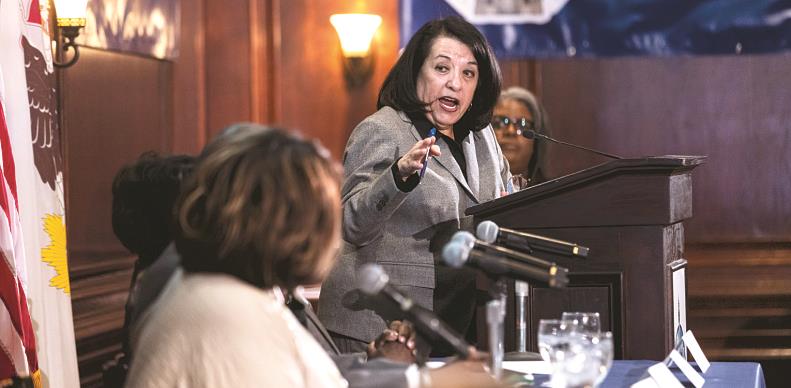Smart investment can unlock North Lawndale’s economic potential

Teresa Cordova, director of the Great Cities Institute at the University of Illinois at Chicago, speaks about issues in North Lawndale during a City Club of Chicago panel discussion. ANTHONY VAZQUEZ/SUN-TIMES
It’s an often-told story that the North Lawndale community has been ravaged by decades of economic disinvestment.
But a study released this week found North Lawndale residents spend $124 million a year outside their neighborhood, purchasing items that can’t be found within their community.
Keeping more of that money closer to home could be key to revitalizing the community, according to the study conducted by University of Illinois at Chicago’s Great Cities Institute and commissioned by the North Lawndale Christian Development Corporation.
“The well-being of residents is bolstered by the economic health of a neighborhood,” Great Cities Institute Director Teresa Córdova said Monday as she presented the study at the City Club of Chicago. “When those wealth-building opportunities are denied, you start to have various quality of life indicators that are parallel to that.”
The findings are valuable —and should be studied — by city planners, business owners or anyone interested in revitalizing North Lawndale and similar neighborhoods that are wrongly seen as too poor to support proper economic development.
An investment — with a return
The study, called the Lawndale Service Area Databook, also found that 3,000 jobs in North Lawndale have been held by non-residents of the community over the past 10 years — because more than 21% of the neighborhood’s jobs require a bachelor’s degree, but only 12.7% of the residents are college graduates.
And while whites make up less than 3% of North Lawndale’s population, they hold more than half of the community’s jobs.
The solutions in North Lawndale include significant investment in early childhood and elementary education, and creating jobs and internships that help residents start careers in health care and education, which are predominant in the neighborhood, the study said.
We think the city could use that $124 million figure — that’s potentially $1.2 billion over a decade — to help lure more businesses to the neighborhood’s beleaguered main streets such as Ogden and Kedzie avenues, and along public transit nodes.
Mayor Lori Lightfoot’s Invest South/West program has already targeted North Lawndale for improvement. The study can help inform these efforts.
If nothing else, the Great Cities study ought to dislodge the mindset that revitalizing neighborhoods such as North Lawndale is charity. It isn’t. It’s a good investment in a community and its people.
And all good investments tend to bring a return.
But a study released this week found North Lawndale residents spend $124 million a year outside their neighborhood, purchasing items that can’t be found within their community.
Keeping more of that money closer to home could be key to revitalizing the community, according to the study conducted by University of Illinois at Chicago’s Great Cities Institute and commissioned by the North Lawndale Christian Development Corporation.
“The well-being of residents is bolstered by the economic health of a neighborhood,” Great Cities Institute Director Teresa Córdova said Monday as she presented the study at the City Club of Chicago. “When those wealth-building opportunities are denied, you start to have various quality of life indicators that are parallel to that.”
The findings are valuable —and should be studied — by city planners, business owners or anyone interested in revitalizing North Lawndale and similar neighborhoods that are wrongly seen as too poor to support proper economic development.
An investment — with a return
The study, called the Lawndale Service Area Databook, also found that 3,000 jobs in North Lawndale have been held by non-residents of the community over the past 10 years — because more than 21% of the neighborhood’s jobs require a bachelor’s degree, but only 12.7% of the residents are college graduates.
And while whites make up less than 3% of North Lawndale’s population, they hold more than half of the community’s jobs.
The solutions in North Lawndale include significant investment in early childhood and elementary education, and creating jobs and internships that help residents start careers in health care and education, which are predominant in the neighborhood, the study said.
We think the city could use that $124 million figure — that’s potentially $1.2 billion over a decade — to help lure more businesses to the neighborhood’s beleaguered main streets such as Ogden and Kedzie avenues, and along public transit nodes.
Mayor Lori Lightfoot’s Invest South/West program has already targeted North Lawndale for improvement. The study can help inform these efforts.
If nothing else, the Great Cities study ought to dislodge the mindset that revitalizing neighborhoods such as North Lawndale is charity. It isn’t. It’s a good investment in a community and its people.
And all good investments tend to bring a return.

